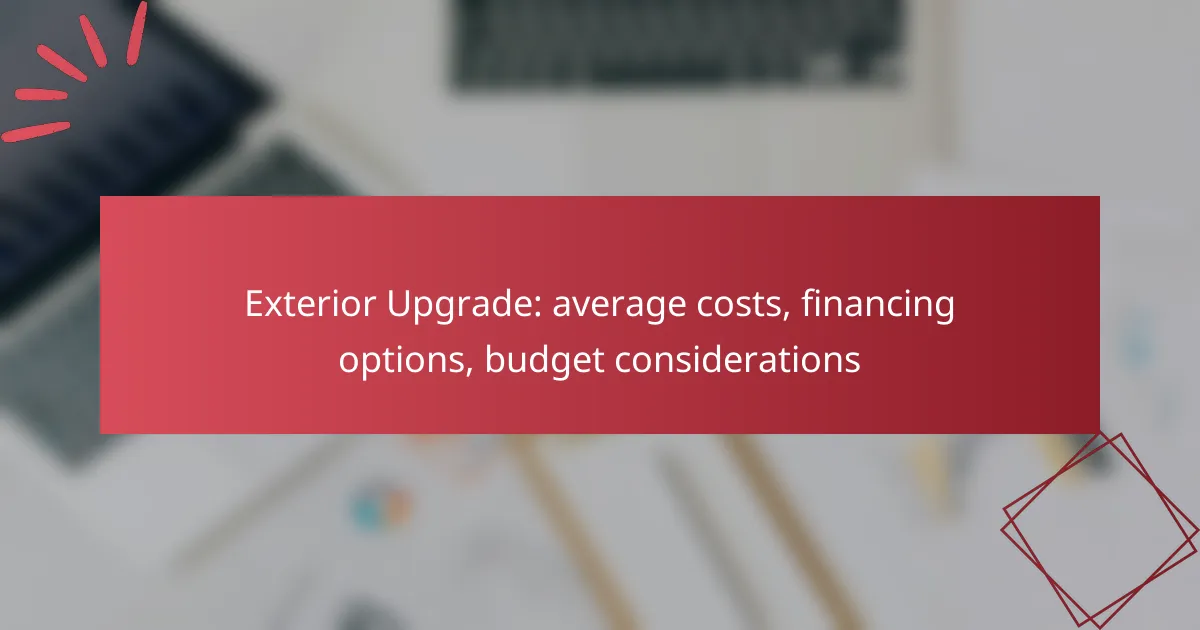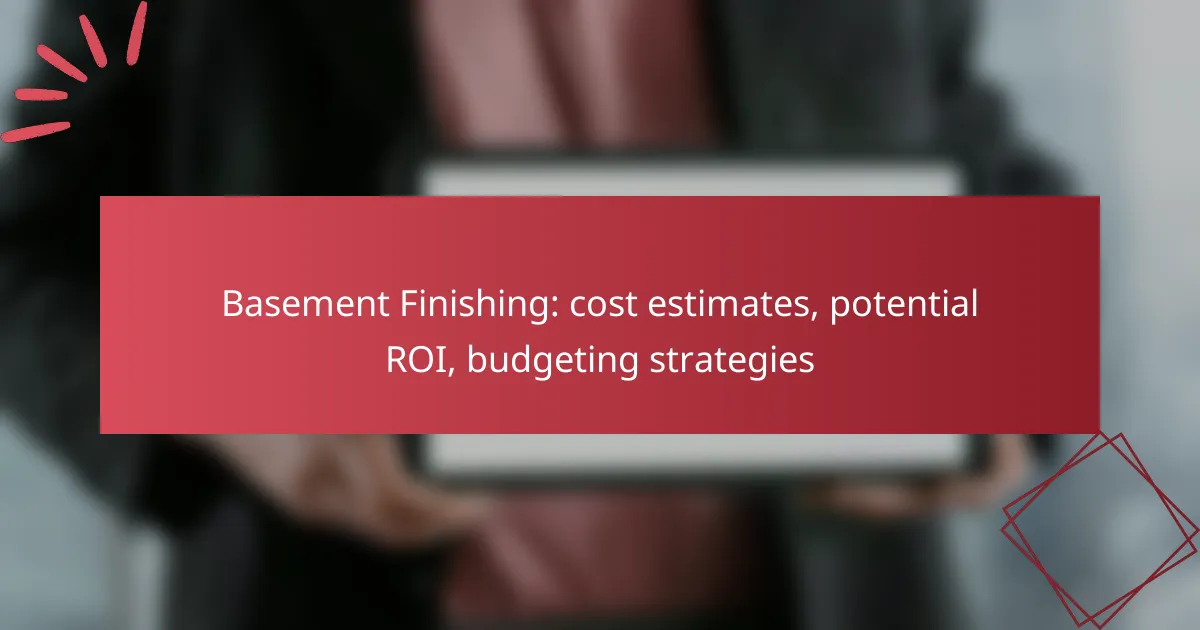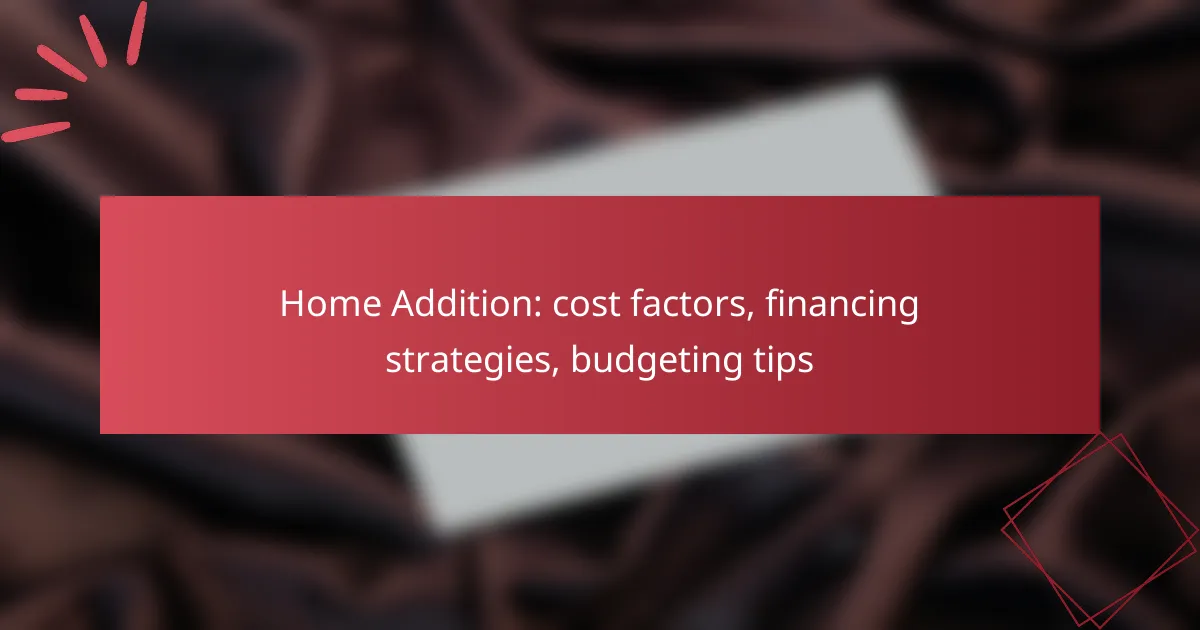Upgrading the exterior of your home can enhance its curb appeal and value, but costs can vary widely depending on the type of upgrade and materials chosen. Homeowners should be prepared to invest anywhere from a few thousand to tens of thousands of dollars, making it essential to explore various financing options like home equity loans and personal loans. Careful budgeting is crucial to manage expenses and accommodate any unexpected costs that may arise during the project.

What are the average costs of exterior upgrades in the United States?
The average costs for exterior upgrades in the United States can vary significantly based on the type of upgrade and the materials used. Homeowners should expect to spend anywhere from a few thousand dollars to tens of thousands, depending on the scope of the project.
Cost range for siding replacement
The cost for siding replacement typically ranges from $5,000 to $15,000, depending on the material chosen. Vinyl siding is often the most affordable option, while fiber cement and wood siding can be more expensive.
When budgeting for siding replacement, consider both the cost of materials and labor. Installation costs can vary by region, so obtaining multiple quotes from contractors is advisable.
Cost range for roofing installation
Roofing installation costs generally fall between $7,000 and $15,000, influenced by factors such as roofing material and roof size. Asphalt shingles are usually the least expensive, while metal and tile roofs can significantly increase the overall cost.
It’s essential to factor in the potential need for underlayment and flashing, which can add to the total expense. Regular maintenance can also extend the lifespan of your roof, potentially saving money in the long run.
Cost range for window replacement
Replacing windows can cost between $300 and $1,000 per window, depending on the type and energy efficiency of the windows selected. Vinyl windows are typically more affordable, while wood and custom windows can be pricier.
Consider energy-efficient windows, which may have a higher upfront cost but can lead to savings on energy bills over time. Always check for local rebates or incentives for energy-efficient upgrades.
Cost range for deck installation
The cost of deck installation varies widely, ranging from $4,000 to $15,000 based on materials and size. Pressure-treated wood is often the least expensive option, while composite materials and exotic woods can increase costs significantly.
When planning a deck installation, consider additional features such as railings, lighting, and built-in seating, which can add to the overall budget. Hiring a professional can ensure proper installation and adherence to local building codes.
Factors affecting overall costs
Additionally, the complexity of the project and any necessary permits or inspections can affect the final price. It’s crucial to plan ahead and budget for unexpected expenses that may arise during the upgrade process.

What financing options are available for exterior upgrades?
Several financing options can help homeowners manage the costs of exterior upgrades. These include home equity loans, personal loans, credit card financing, and government grants or incentives, each with distinct features and considerations.
Home equity loans
Home equity loans allow homeowners to borrow against the equity they have built in their property. Typically, these loans offer lower interest rates compared to personal loans, making them an attractive option for larger projects.
Borrowers can usually access 80% to 90% of their home’s equity, which means if your home is valued at $300,000, you might be able to borrow between $240,000 and $270,000. However, keep in mind that your home serves as collateral, so failure to repay could lead to foreclosure.
Personal loans
Personal loans are unsecured loans that can be used for various purposes, including exterior upgrades. They generally have higher interest rates than home equity loans but do not require collateral.
Loan amounts typically range from $1,000 to $50,000, with repayment terms from two to seven years. It’s essential to compare lenders to find the best rates and terms, as these can vary significantly based on your credit score and financial history.
Credit card financing
Using credit cards for financing exterior upgrades can be convenient, especially if you have a card with a 0% introductory APR offer. This allows you to make purchases without immediate interest, provided you pay off the balance before the promotional period ends.
However, be cautious of high-interest rates that can apply after the promotional period, which can lead to significant debt if not managed properly. It’s advisable to keep your credit utilization low to maintain a healthy credit score.
Government grants and incentives
Government grants and incentives can significantly reduce the cost of exterior upgrades, especially for energy-efficient improvements. Programs vary by location, so it’s essential to check local and state resources for available options.
For instance, some states offer rebates for energy-efficient windows or roofing, while federal programs may provide tax credits for solar panel installations. Researching these opportunities can help you save money while enhancing your home’s exterior.
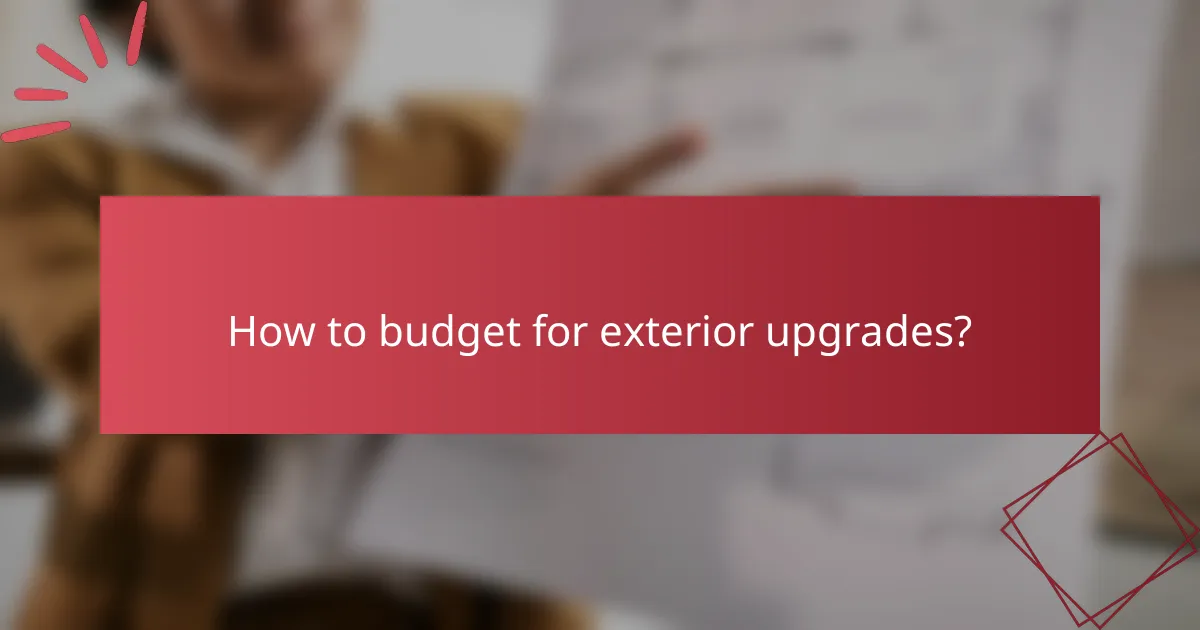
How to budget for exterior upgrades?
Budgeting for exterior upgrades involves assessing your financial capacity, understanding the costs involved, and planning for potential unexpected expenses. A well-structured budget helps ensure that your project stays on track and aligns with your financial goals.
Setting a realistic budget
To set a realistic budget for exterior upgrades, start by evaluating your current financial situation and determining how much you can afford to spend. Consider both your savings and any potential financing options, such as loans or credit lines, that may be available to you.
Research typical costs for the specific upgrades you are considering, as these can vary significantly based on location and materials. Aim to allocate a budget that not only covers the upgrades but also leaves room for contingencies.
Prioritizing upgrades
Prioritizing upgrades is crucial to ensure that your budget is spent effectively. Identify which exterior improvements will provide the most value or are most urgent, such as repairs to structural elements or energy efficiency enhancements.
Consider creating a list of upgrades ranked by importance and potential return on investment. This approach allows you to focus on essential projects first, ensuring that your budget is utilized for the most impactful changes.
Estimating labor and material costs
Estimating labor and material costs accurately is essential for effective budgeting. Labor costs can vary widely based on the complexity of the work and local wage rates, while material costs depend on the quality and type of materials chosen.
Gather quotes from multiple contractors to get a clearer picture of labor costs. For materials, research prices at local suppliers or online to find competitive rates. A rough estimate for labor might range from 20% to 50% of your total budget, depending on the project scope.
Planning for unexpected expenses
Planning for unexpected expenses is a critical aspect of budgeting for exterior upgrades. It’s advisable to set aside a contingency fund, typically around 10% to 20% of your total budget, to cover unforeseen costs that may arise during the project.
Common unexpected expenses include hidden damage discovered during renovations or price increases in materials. By anticipating these possibilities, you can avoid financial strain and keep your project on schedule.

What are the best practices for selecting contractors?
Selecting the right contractor is crucial for successful exterior upgrades. Focus on finding qualified professionals who have a solid reputation and can meet your specific project needs.
Researching local contractors
Start by compiling a list of local contractors who specialize in exterior upgrades. Utilize online resources, community boards, and recommendations from friends or family to identify potential candidates.
Check their websites and social media profiles for portfolios of past work, as well as any certifications or licenses they may hold. This initial research will help you narrow down your options to those who are most qualified for your project.
Checking references and reviews
Once you have a shortlist of contractors, reach out to their previous clients for references. Ask about their experience, the quality of work, and whether the project was completed on time and within budget.
Additionally, read online reviews on platforms like Google, Yelp, or Angie’s List. Pay attention to both positive and negative feedback to get a balanced view of each contractor’s reliability and workmanship.
Comparing quotes
After gathering information, request detailed quotes from your top choices. Ensure that each quote includes a breakdown of costs, timelines, and materials to facilitate comparison.
While the lowest bid may be tempting, consider the overall value, including the contractor’s reputation and the quality of materials proposed. Aim for a balance between cost and quality to ensure a successful project outcome.
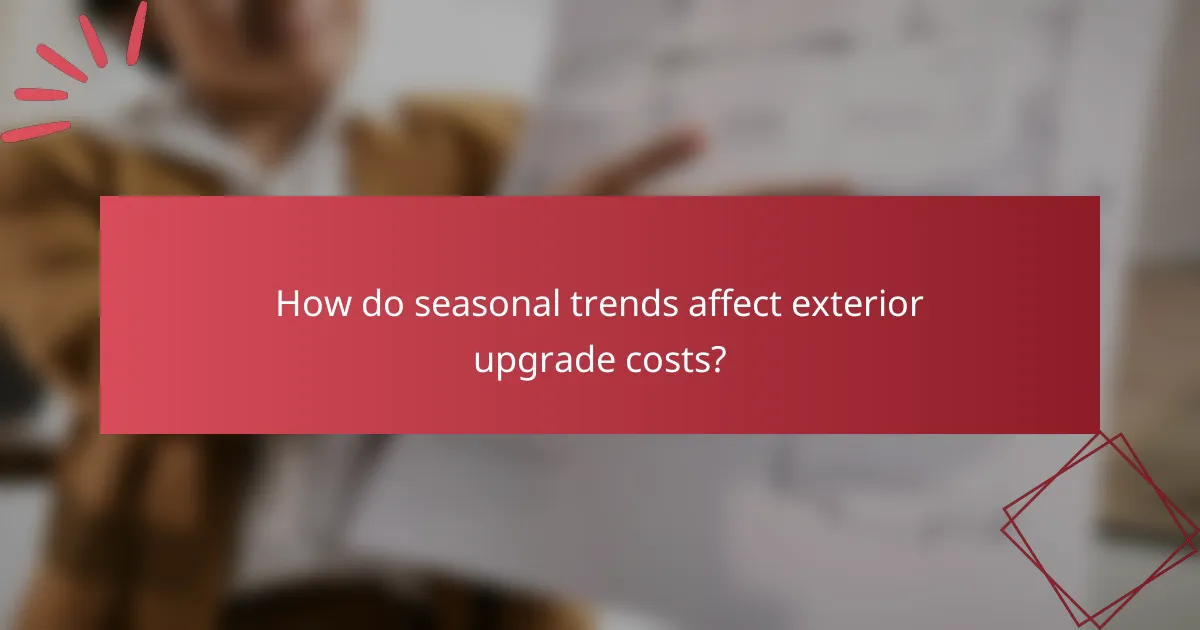
How do seasonal trends affect exterior upgrade costs?
Seasonal trends significantly influence the costs of exterior upgrades, with demand fluctuations impacting pricing and availability. Homeowners should consider these trends when planning their projects to optimize budget and timing.
Impact of summer demand
Summer is typically the peak season for exterior upgrades, leading to higher demand and, consequently, increased costs. Contractors may charge more due to their busy schedules, and homeowners might face longer wait times for project completion.
To manage costs during this season, consider scheduling upgrades early in the summer or exploring off-peak times, such as late spring. This approach can help secure better rates and availability.
Winter pricing considerations
Winter often sees a dip in demand for exterior upgrades, which can lead to lower prices as contractors seek work. However, weather conditions can complicate projects, potentially leading to delays or additional costs for winterization measures.
When planning winter upgrades, ensure that your contractor is equipped to handle cold weather conditions. Additionally, be prepared for possible price fluctuations based on local regulations regarding winter work and material availability.
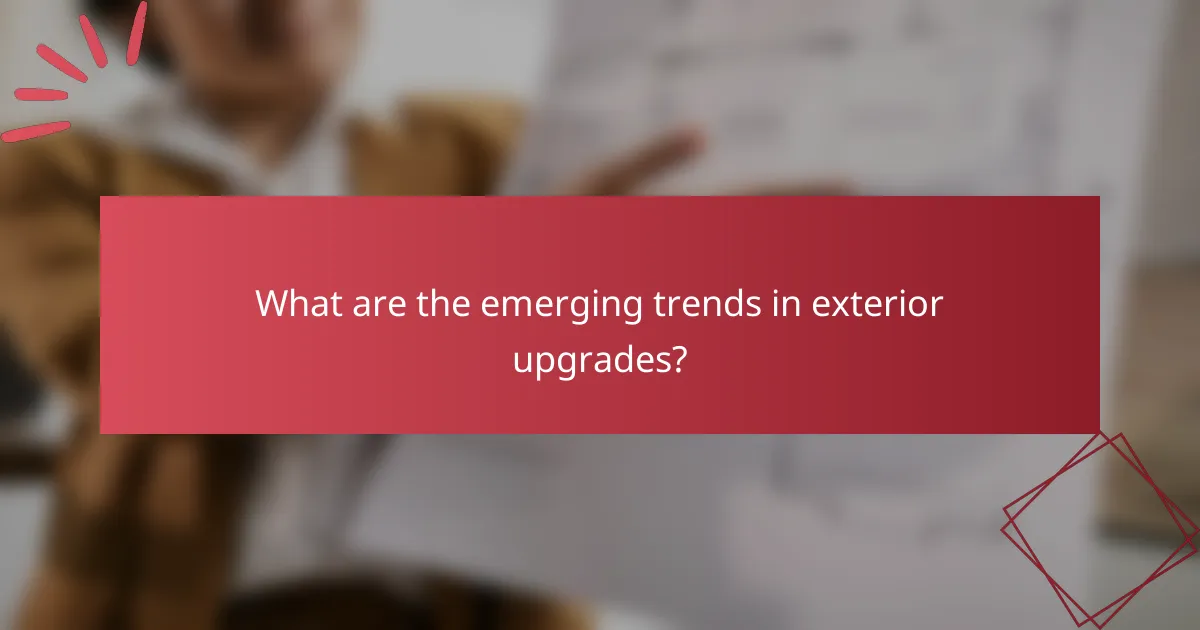
What are the emerging trends in exterior upgrades?
Emerging trends in exterior upgrades focus on sustainability, technology integration, and aesthetic enhancements. Homeowners increasingly prioritize energy-efficient materials, smart home features, and modern designs that enhance curb appeal.
Average costs of exterior upgrades
The average costs of exterior upgrades can vary widely based on the type of upgrade and materials used. For instance, siding replacement might range from $5,000 to $15,000, while roofing can cost between $7,000 and $20,000. Landscaping upgrades typically fall between $2,000 and $10,000, depending on the scope of work.
Labor costs also play a significant role in the overall expense. Hiring professionals can add 20-50% to the material costs, so it’s essential to get multiple quotes before proceeding. Consider local market rates, as these can differ significantly across regions.
Financing options for exterior upgrades
Homeowners have several financing options for exterior upgrades, including personal loans, home equity loans, and credit cards. Personal loans typically offer fixed rates and terms, making them a popular choice for smaller projects.
Home equity loans allow homeowners to borrow against their property’s value, often at lower interest rates. However, this option requires sufficient equity and can involve longer approval processes. Additionally, some contractors offer financing plans, which can be convenient but may come with higher interest rates.
Budget considerations for exterior upgrades
When planning for exterior upgrades, establishing a clear budget is crucial. Start by determining the maximum amount you can afford, factoring in both materials and labor. Prioritize upgrades that provide the best return on investment, such as energy-efficient windows or durable siding.
It’s also wise to set aside a contingency fund of about 10-20% of your budget for unexpected expenses. This can help you manage costs effectively and avoid financial strain during the project. Always review your options and make informed decisions to ensure your upgrades align with your financial goals.
